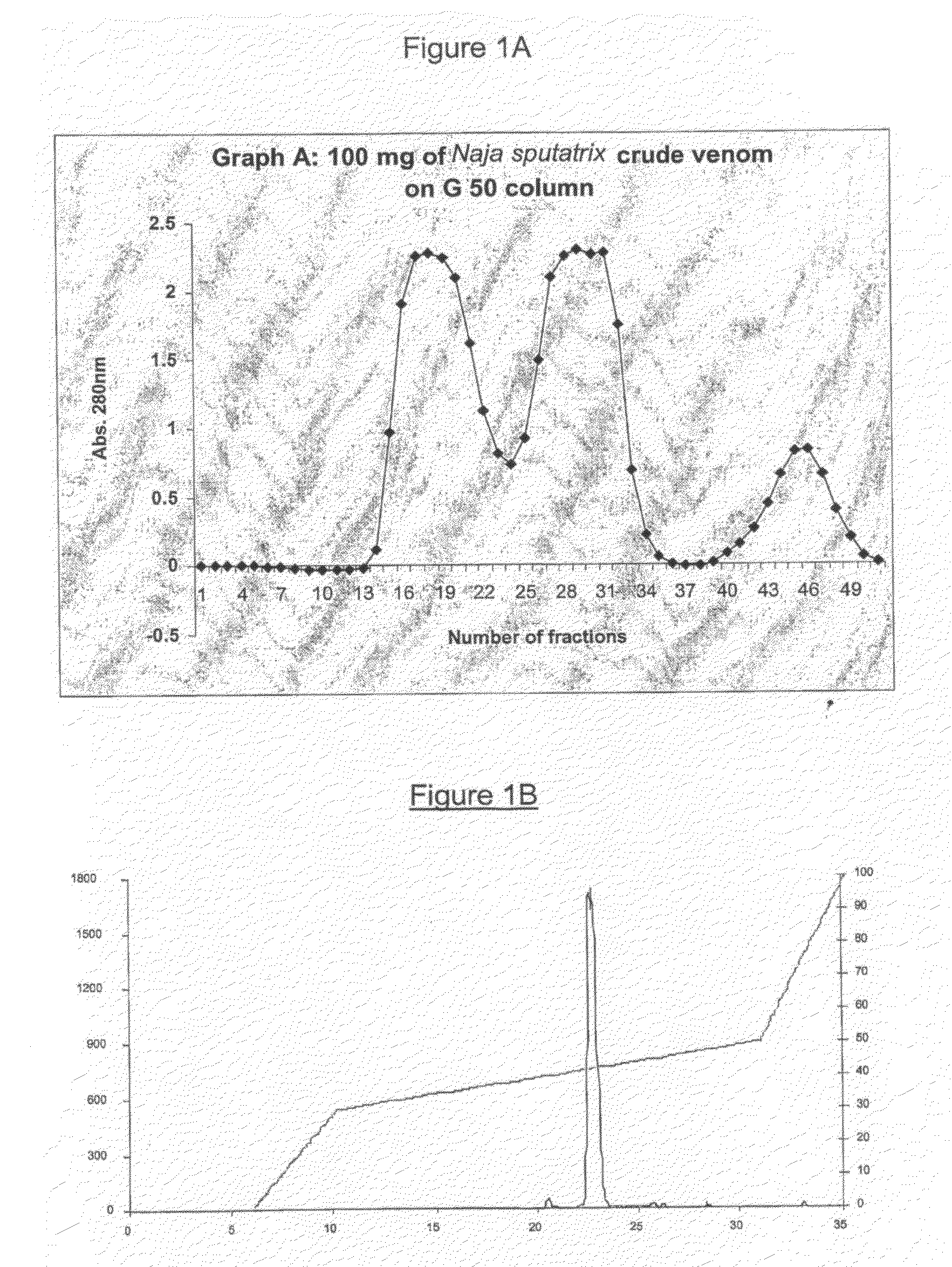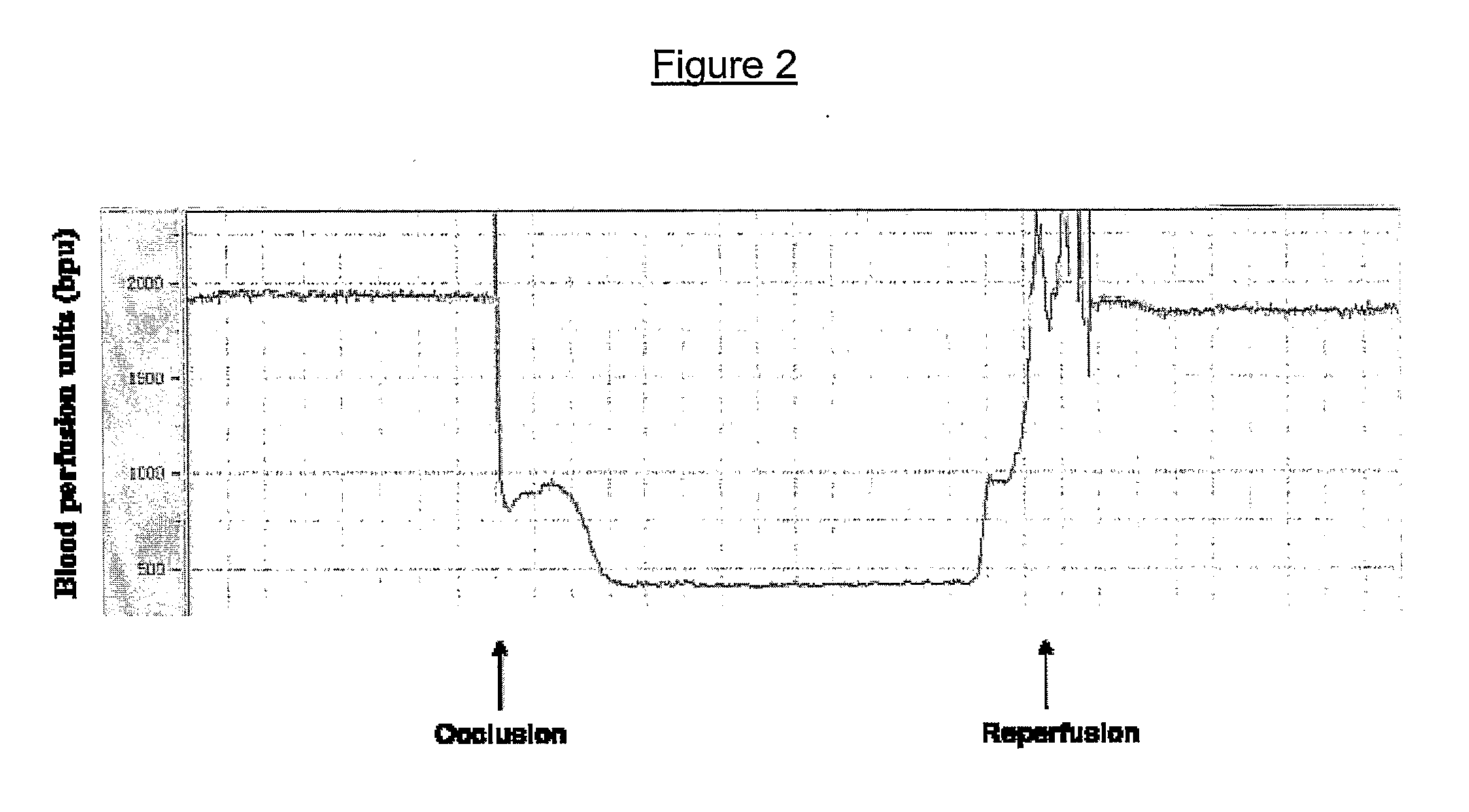Phospholipase(s) and Use(s) Thereof
a phospholipase and phospholipase technology, applied in the field of medicine, can solve the problems of increasing intracellular nasup>2+/sup>, reducing so as to reduce the size of the infarct, and reduce the effect of ischemic cell death
- Summary
- Abstract
- Description
- Claims
- Application Information
AI Technical Summary
Benefits of technology
Problems solved by technology
Method used
Image
Examples
example 1
N. sputatrix Venom Fractionation
[0157]N. sputatrix crude venom (Sigma Chemicals, St Louis, USA) was fractionated on Sephadex G-50 gel filtration chromatography using 50 mM Tris-HCl pH8.0. The PLA2 containing protein fractions (Peak 1, FIG. 1A) were pooled and separated further on a reverse-phase High Performance Liquid Chromatography (HPLC) using C18 Jupiter column (FIG. 1B). The partially purified PLA2 protein was fractionated on a second Reversed phase-High Performance Liquid Chromatography (RP-HPLC), using a C4 Jupiter column (FIG. 1C). The buffer system used for the RP-HPLC were buffer A, 0.1% trifluoroacetic acid (TFA) in filtered H2O and buffer B, 0.1% TFA in 75% acetonitrile. All proteins were quantitated using Bradford Assay Reagent (Bio-Rad Laboratories, USA).
cDNA (nucleotide) sequence (SEQ ID NO:1) encoding NsPLA2 precursor (L42005.1)
tcacctcgga caaaatgaat cctgctcacc ttctgatcctggcagcagtt tgtgtctccc ccttaggagc ctcctctaatcgtcccatgc ctctcaacct ctatcagttc aaaaacatggttcaatgtac t...
example 2
Intravenous Administration of NsPLA2 Confers Protection During Transient Ischemia
[0162]Transient cerebral focal ischemia was induced by the intraluminal insertion of a nylon suture to occlude the left middle cerebral artery (MCA). The presence of focal occlusion was confirmed using the Laser Doppler that measures the cerebral blood flow in the region of middle cerebral artery (FIG. 2). The ischemic period lasted 60 min, after which the suture was removed and reperfusion initiated. Animals were sacrificed 23 hr later. Phospholipase A2 (PLA2) from Naja sputatrix venom, was injected intravenously, at a dose of 30 μg / 200 g body weight, immediately-(0 min), 5-, 15-, 30- and 60 min after MCAo (middle cerebral artery occlusion). The amount of NsPLA2 administered is way below its LD50 value (125 μg / 200 g body weight) and did not induce any signs of toxicity in our studies. Histopathological analysis was carried out to assess the extent of infarction in the brains of rats (FIG. 3A).
[0163]The...
example 3
MK801, but not tPA, Confers Neuroprotection
[0165]The thrombolytic tissue plasminogen activator (tPA) is a serine protease that initiates the process of clot degradation by converting plasminogen to activated plasmin. Animal experiments had demonstrated that tPA improved functional outcomes and reduced infarct volumes (Zivin et al, 1985; 1988). The National Institute of Neurological Disorders and Stroke study (The National Institute of Neurological Disorders and Stroke rtPA Stroke Study Group, 1995) established that acute administration of tPA significantly reduced the incidence of long-term disability despite a slight increase on the risk of intracerebral hemorrhage, leading to its approval by the Food and Drug Administration for the treatment of acute ischemic stroke. Dizocilpine, or MK801, is a non-competitive antagonist of the NMDA receptor and has been shown in several animal studies to confer neuroprotection by inhibiting glutamate-induced excitotoxicity (Buchan et al, 1992; Ya...
PUM
| Property | Measurement | Unit |
|---|---|---|
| size | aaaaa | aaaaa |
| pH | aaaaa | aaaaa |
| concentration | aaaaa | aaaaa |
Abstract
Description
Claims
Application Information
 Login to View More
Login to View More - R&D
- Intellectual Property
- Life Sciences
- Materials
- Tech Scout
- Unparalleled Data Quality
- Higher Quality Content
- 60% Fewer Hallucinations
Browse by: Latest US Patents, China's latest patents, Technical Efficacy Thesaurus, Application Domain, Technology Topic, Popular Technical Reports.
© 2025 PatSnap. All rights reserved.Legal|Privacy policy|Modern Slavery Act Transparency Statement|Sitemap|About US| Contact US: help@patsnap.com



